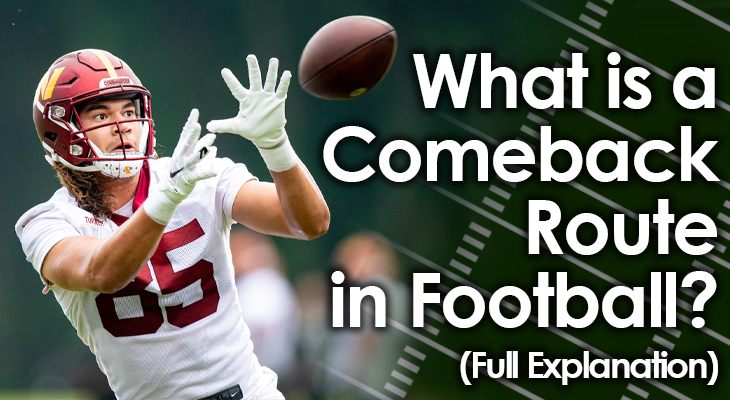The key to any successful passing route is keeping defenders on their toes, constantly guessing where the receiver will go.
Some routes include more deception than others -- and one of the top routes on that list is the Comeback route.
The Comeback route is quite simple in its design.
It has the receiver sprint straight forward for a certain number of yards, and then stop on a dime and "come back" toward the quarterback.
This is where the route gets its name from -- the fact that the receiver will work his way back in toward the quarterback once he makes his stop.
The route looks to take advantage of both momentum and anticipation by defenders to hopefully get a receiver open on a relatively shorter route.
Let's take a closer look at what the Comeback route is, and how teams should run it from start to finish.
Purpose of a Comeback Route
As mentioned earlier, the goal of the comeback route is to trick the defender.
The goal is to make him think that the receiver is going to run a deep route, only to break it off suddenly and come back toward the quarterback.
By sprinting straight forward right off the line of scrimmage, the hope is that the defender will think the receiver is running a Go route deep down the field.
In many man-to-man coverage cases, the defender will turn out of his backpedal and try to keep up with the receiver.
In zone coverage, the initial defender will still need to get considerable depth to be able to assist the defender over the top.
In both scenarios, there should be plenty of room "underneath" if the receiver runs the route effectively.

Using the Comeback Route
The Comeback route is a shorter route compared to some of the other ones.
It's designed to initially get a depth of about 10 yards before the receiver breaks it off and comes back toward the quarterback.
This doesn't necessarily mean that the Comeback is only designed to gain short yardage, though. The route can also help an offense get a few good yards and move the sticks.
At the same time, it can also be a way to get the ball into a speedy receiver's hands with some separation between him and the defender.
Then, the receiver will have the ability to make some moves and make magic happen with the ball in his hands.
In most cases, the Comeback route will end up toward the sideline, rather than in toward the middle of the field (that's typically referred to as a Hitch).
This allows the receiver to get some space and avoid the "teeth" of the defense -- located in the middle of the field.
Running the Comeback Route
There are obviously two parts to the Comeback route -- the sprint at the outset followed by the stop and abrupt move back in toward the quarterback.
Part 1: The Sprint
To run a successful Comeback route, the receiver must convince the defender that he is running a Go route or a deeper route down the field.
The beginning of the route is the key to its overall success.
At the snap, the receiver should put his head down and sprint forward.
He should not look back toward the quarterback at all, in an attempt to convince the defender he's running a deep route.
The goal here is really sell the Go route and make the defender turn his back to the quarterback.
Part 2: The Turn
At the pre-determined distance (usually 10 yards), the receiver needs to stop his downfield run almost immediately, and come back toward the quarterback.
To do this, he'll need to quickly chop his feet and then plant with his inside foot -- if he's on the right side of the field, that'll be his left foot, and vice versa.
He'll need to plant with his inside foot so that he can push off as he comes back in toward the line of scrimmage but also out toward the sideline.
If he plants on his outside foot, it'll be difficult to get to the outside of the field while still having good vision and body position to catch a pass from the QB.
By pushing off using the inside foot, the receiver will be doing two things:
- He'll create a few yards' worth of separation from the defender (hopefully).
- He'll use his body as a shield from the ball.
When he comes back toward the quarterback and out toward the sideline, the defender will have to come through the receiver's back in order to get to his hands, where the ball should be thrown.
A well-executed Comeback route and pass will often either result in a completion or a pass interference penalty on the defender.
Conclusion
The Comeback route is a fairly simple route to teach receivers, but it takes a lot of practice to master.
He'll need to learn to completely sell the deep route to avoid giving away the break off his route.
The receiver also needs to make a quick, precise and powerful cut back in toward the quarterback.
What's more, the Comeback route takes a lot of timing with the quarterback.
The quarterback needs to know where the receiver is going to end up, as he'll need to release the ball before the receiver even turns around.
This requires the receiver to have great hands and anticipate a throw as he's making his cut and turning around.

